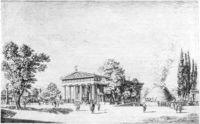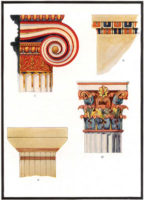From the Promenade, Part Two
Design matters, whether in Gotham or small-town America.
The view from the Promenade near my longtime home in Brooklyn Heights may be New York’s finest. The city and its waterfront snap into perspective from across the river. Manhattan’s proud towers cluster, then crash toward the water’s edge, their juncture fragmented into a splayed collar of docks and piers, cafés, and bubble-topped tennis courts. From this distance, the city looms whole and iconic, the culmination of heroic materialism. The architecture takes your breath away.
 |
Just at my feet, the riverfront is changing, morphing before our eyes from a gritty, on-the-waterfront industrial zone into Brooklyn Bridge Park. Exit, Brando; hello, Mommy. Day after day, I follow the changes at the former docklands: Pier One, from a flat cipher into a rolling meadow and hillside; down the East River, from cargo containers to howling kids hanging from the swings and climbing gyms of Pier Six. On balmy evenings this past summer at the newly opened Pier One, a soprano from the Metropolitan Opera, Susanna Phillips, held an audience of thousands silently enthralled as her arias carried a hundred feet up the bluff to my home, where her lilting voice reached an editor and his wife perched above, conveyed to another plane. I was there.
The transformation of New York’s waterfront, which we have written about extensively at architectural record, although seeming to come with the wave of a wand, actually engaged scores of professionals, including the landscape architecture firm Michael Van Valkenburgh Associates, the City Planning authorities, and legions of neighborhood advocates. Architects, engineers, and scientists have taken part. The park composes only one element in a city softening itself for a new, more humane way of living, opening its heart to new sensibilities — all powered by design and civic will. Design professionals and planners have been at the forefront, articulating a new urban vision.
The view from the riverside park in my hometown, Columbus, Mississippi, is more languid. It is amazing that the river is apparent at all, below another bluff. For 50 years, the water’s edge lay hidden behind scrubby undergrowth and scattered debris, unapproachable and walled off below a wonderful, rumbling bridge. People feared flooding; rivers rise down South. Things began to change when a friend of mine, a local architect, stared down at the clutter, rolled up his sleeves, and helped improve the community’s perception of itself.
The park did not happen overnight; the idea percolated slowly in one person’s consciousness. The genesis of that idea emerged 35 years ago, after my friend had moved back to Columbus from a successful partnership in an urban firm. He did what many architects do — he established a small practice, joined the civic clubs, acquired clients, sat on tedious zoning and planning boards, made buildings, fought for historic preservation and for his downtown. He also realized, with a singular vision, that the riverfront, which lay 90 feet below the main street, deserved to be shared.
Someone else got the job, but the service he performed was just as vital: He framed the debate that made it possible, then fought for the improvements. What began with an individual’s commitment broadened into shared vision and collaboration. Today, the park has enjoyed years of completion. Each time I return to my hometown, I walk and run along a pathway through mythic trees bordering the river on a two-mile stretch of managed wildness near a small town’s heart. The ideas that began over a decade ago have taken root, prompting a community to stroll, bike, walk the dog, push the wheelchair, take the babies out at all hours of the day and evening on a pathway that could lead to a place called Oz. Both the dreaming and the political moxie worked.
There is differentiation of scale, but no hierarchy of values between the two riverfronts. Both count. The small-town story is unambiguous; the city’s, exceedingly complex. Whether in sparsely settled mid-America or across the East River, by one architect or a larger group, small actions are additive, weaving together into a seamless community, uniting those who care about and are committed to the built environment. The little park, as much as the great riverfront, bears witness to design’s transformational power.
In the almost 15 years that I have been privileged to observe and reflect at Architectural Record, after writing 171 regular editorials and traveling the country and the larger world, despite the difficulties presented by natural and human-provoked disasters, despite the wrath unleashed by hurricanes or the disparities of the human condition, I am as convinced as I was when I arrived of the power of design. Properly employed, design conveys our nuances and bold hopes, and can improve the human condition if we become watchful, creative, and committed stewards of the natural world we have inherited.
It is seductive, from the Promenade, to marvel at the city’s buildings, the monumental artifacts of human ingenuity and will. However, sometimes the overlooked story is not what architects build, but the influence their ideas, commitment, and efforts have, in my hometown or your own.



